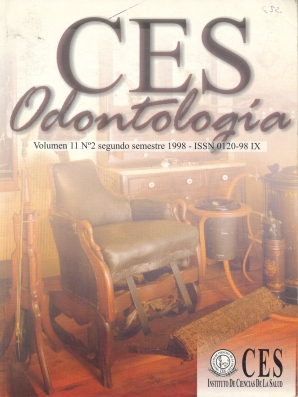EFICACIA DE LA TÉCNICA DE DISTRACCIÓN CONTINGENTE CON MATERIAL AUDITIVO EN EL COMPORTAMIENTO DE PACIENTES ENTRE 4 Y 6 AÑOS DE EDAD
Abstract
El objetivo de este estudio fue evaluar la eficacia de la técnica de distracción contingente con el uso de material auditivo. Se seleccionaron 18 pacientes entre 4 y 6 años de edad que requirieran tratamiento odontológico restaurador con el uso de anestesia local. A los pacientes se les realizó una cita control donde se utilizaron técnicas de manejo convencionales y luego una cita experimental donde se aplicaron técnicas convencionales en combinación con la técnica de distracción contingente. Las demás condiciones experimentales tales como el operador, la hora, el sitio de atención y el tipo de tratamiento fueron iguales en ambas citas. Todos los procedimientos fueron filmados y editados. Dos odontopediatras previamente calibrados observaron los videos editados y calificaron el comportamiento global y durante tres periodos de tratamiento (inicial, intermedio, final) utilizando la Escala de Frankl. Al comparar tanto el comportamiento global como el de cada uno de los periodos de tratamiento entre la cita control y experimental, los resultados revelaron diferencias estadísticamente significativas de acuerdo con la prueba de Rangos de Friedman, que indicaban que la técnica fue efectiva. En conclusión, los hallazgos de esta investigación sugieren que la técnica de distracción contingente es eficaz para mejorar el comportamiento de pacientes entre 4 y 6 años de edad que requieran tratamiento odontológico. ABSTRACT Efficacy of Contingent Distraction with Audiotaped Material as a Behavior Management TechniqueIn Patients Between 4 and 6 Years Old. The purpose of this study was to evaluate the efficacy of contingent distraction with audiotaped material as a behavior management technique. Eighteen patients between 4 and 6 years of age which required restorative dental treatment with the use of local anesthetic, were selected. Patients were initially submitted to a control visit where conventional behavior management techniques were used and then to an experimental visit where conventional techniques were used in combination with audiotaped contingent distraction. Other experimental conditions such as operator, time, location and type of treatment were the same for both appointments. All procedures were filmed and edited. Two previously calibrated pediatric dentists observed the videos and evaluated the behavior of each patient. The Frankl Behavior Scale was used to rate overall behavior and during three different treatment periods ( initial, intermediate, final). Comparisions between control and experimental visits using Friedman's Statistical Analysis revealed that significant differences were present in all cases and indicated that the technique was effective. It was therefore concluded that contingent distraction with audiotaped material was effective in improving the behavior of children between 4 and 6 years of age who required restorative dental treatment.Downloads
Download data is not yet available.
Downloads
Published
2009-11-24
How to Cite
1.
Muñoz N, Álvarez IM, Cárdenas JM. EFICACIA DE LA TÉCNICA DE DISTRACCIÓN CONTINGENTE CON MATERIAL AUDITIVO EN EL COMPORTAMIENTO DE PACIENTES ENTRE 4 Y 6 AÑOS DE EDAD. CES odontol. [Internet]. 2009 Nov. 24 [cited 2024 May 17];11(2):13-20. Available from: https://revistas.ces.edu.co/index.php/odontologia/article/view/862
Issue
Section
Artículo de Investigación Científica y Tecnológica
| Article metrics | |
|---|---|
| Abstract views | |
| Galley vies | |
| PDF Views | |
| HTML views | |
| Other views | |



